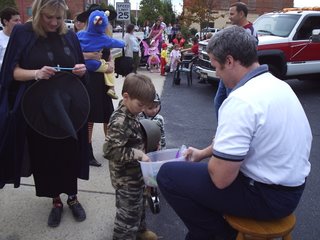
A group of residents and business people learned about Clayton’s proposed historic district at an introductory meeting at the Clayton Center on October 18. Town Council members Bob Ahlert and Michael Grannis and Clayton Downtown Development Association chair, Joyce Blackley and Treasure Ed Knight were also in attendance.
National Register consultant Nancy Van Dolsen, of Wilson, spoke about the preliminary boundaries, the process she was going to use in researching the district properties and the timeline of the nomination process for having the historic district listed on the National Register of Historic Places. Claudia Brown, Branch Supervisor of the State Historic Preservation Office in Raleigh spoke about what comprises a historic district; effects of being in a historic district and provided information about tax credits for historic rehabilitation of eligible properties.
The period of historical significance in Clayton is from 1880 to 1956. The Clayton Historic District comprises both the town’s historic business district and some of its residential neighborhoods. Buildings within the district include two properties presently on the National Register of Historic Places, the Clayton Banking Company Building, now the Clayton Area Chamber of Commerce, which was listed in 1996; and the Clayton Graded School and Auditorium, now The Clayton Center Auditorium and Conference Center, which was listed in 2001.
The proposed boundaries are as follows:
1) E. Main St. from S. O’Neil St. to Lombard St.
2) S. Fayetteville St. from E. Main St. to E. Blanche St.
3) E. Blanche St. to S. Lombard St.
4) S. Lombard St. to E. Second St.
5) E. Second St. from S. Fayetteville St. to Hardee St.
6) E. Front St. from and including E. Stallings St. to Central St.
Ms. Van Dolsen said that these are preliminary boundaries and that she will inventory the district “tax parcel by tax parcel.” Once that is completed the boundaries could change a little, she said. A historic district is comprised of the “largest concentration of historic buildings without gaps,” she added.
Ms. Brown told the group that, “being listed on the National Register of Historic Places is an honor and places no obligation or restriction on a private owner using their own resources no maintain or restore the property.”
There are several different types of historic districts: a “National Register of Historic Places District,” which is what Clayton is pursuing, and a “Local Designation District”, in which the historic district is conferred by a local governing board following a recommendation by its preservation commission. Clayton doesn’t have a preservation commission.
However, if a contributing, income-producing property is within a National Register District, the property may be eligible for a 20% federal income investment tax credit against the costs of a qualified rehabilitation of the building. An additional 20% tax credit may also be taken at the state level.
Non-income-producing properties may also be eligible for a 30% state-only tax credit. If a property owner pursues the tax credits, then they must follow the Secretary of the Interior’s Standards for Rehabilitation. Ms. Brown said It is highly recommended that a property owner considering applying for tax credits contact the State Historic Preservation Office before beginning work. She added that, “a lot of problems and misunderstandings can be alleviated by a site visit from a SHPO staff person.”
More information about historic districts, tax credits and historic preservation in general can be found at the State Historic Preservation Office website at
www.hpo.dcr.state.nc.us.
The town’s historic district includes examples of commercial, religious, educational, and residential buildings and includes north and south sides of the railroad tracks. The business district is densely developed and has many well-preserved late nineteenth and early twentieth-century commercial buildings with handsome storefronts and decorative cornices. The Study List application describes the residential neighborhoods as featuring, “single-family homes on well-tended lawns, many with large, handsome shade trees. The district’s streets are flanked by poured concrete sidewalks that undulate with the town’s gently rolling topography.”
Commercial buildings are well-represented by the Clayton Banking Company Building (Chamber of Commerce), the B.M. Robertson Mule Company stable, the one-and two-story brick buildings lining both sides of East Main Street, and two masonry stores on East Front Street.
The district includes examples of residential buildings from the late nineteenth through the mid-twentieth century. Among the residences located within the district are excellent examples of the Queen Anne style, including the Mayo House, the Young House, the David Barbour House, and the Hinton House which is one of the finest smaller Queen Anne residences in the county.
Domestic architecture from the late Victorian-era is well-represented in the Barbour House on Horne Street. The Barnes House, Cox House, Massey House, Robertson House and Talton House are all examples of one of the most popular styles within the district, the Colonial Revival style. The Holland House and the Page House are excellent examples of the bungalow form, Well-preserved examples of smaller frame residences appear throughout the district, including some mill houses associated with the Clayton Cotton Mill.
The district also contains some very fine churches, including the Horne Memorial United Methodist Church, St. Augustine’s African Methodist Episcopal Church, and the First Missionary Baptist Church.
The nomination of Clayton’s proposed historic district to the National Register of Historic Places will be one of the first digital applications used in North Carolina. Ms. Van Dolsen said that the new software will make the information and images to be user-friendly. “Once completed, you will be able to type in an address and all the historical descriptions and images will come up at once on the screen,” said Ms. Van Dolsen. Previously, the images were color slides and the nomination information was in a word processing document.
Ms. Van Dolsen is beginning her research work and hopes to have a first draft ready for review by the State Historic Preservation Office sometime this spring. The community will also have an opportunity to review it at that time. Then, she will make the appropriate changes and present the final draft of the nomination for public review and presentation to the National Register Advisory Committee, hopefully in a year or so from now. The NRAC meets only three times a year: February, June and October to make their recommendations.
As part of the research, Ms. Van Dolsen will use Sanborn Insurance Maps, business directories, news articles and standardized histories, but also information from individuals who have knowledge about certain buildings and histories. The best way to contact Ms. Van Dolsen is by email at
woodhamfarm@earthlink.net or by calling Downtown Development Coordinator Bruce Naegelen at 553-1545 or via email at
bnaegelen@townofclaytonnc.org.

 Main Street in downtown Clayton was closed for a few hours today as witches and goblins and Ninja's and firemen and princesses and puppies trolled the streets for candy and other treats from the downtown businesses.
Main Street in downtown Clayton was closed for a few hours today as witches and goblins and Ninja's and firemen and princesses and puppies trolled the streets for candy and other treats from the downtown businesses.






